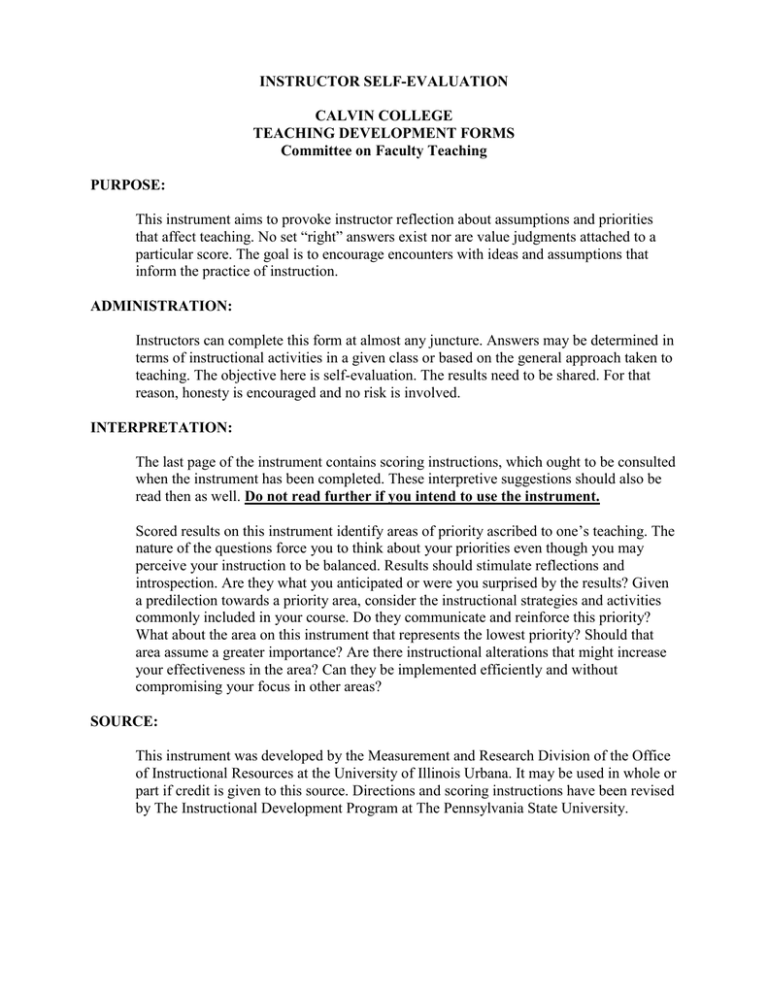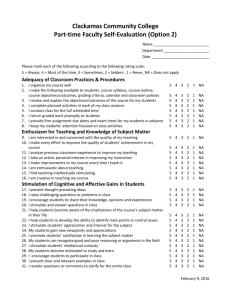the Instructor Self-Evaluation
advertisement

INSTRUCTOR SELF-EVALUATION CALVIN COLLEGE TEACHING DEVELOPMENT FORMS Committee on Faculty Teaching PURPOSE: This instrument aims to provoke instructor reflection about assumptions and priorities that affect teaching. No set “right” answers exist nor are value judgments attached to a particular score. The goal is to encourage encounters with ideas and assumptions that inform the practice of instruction. ADMINISTRATION: Instructors can complete this form at almost any juncture. Answers may be determined in terms of instructional activities in a given class or based on the general approach taken to teaching. The objective here is self-evaluation. The results need to be shared. For that reason, honesty is encouraged and no risk is involved. INTERPRETATION: The last page of the instrument contains scoring instructions, which ought to be consulted when the instrument has been completed. These interpretive suggestions should also be read then as well. Do not read further if you intend to use the instrument. Scored results on this instrument identify areas of priority ascribed to one’s teaching. The nature of the questions force you to think about your priorities even though you may perceive your instruction to be balanced. Results should stimulate reflections and introspection. Are they what you anticipated or were you surprised by the results? Given a predilection towards a priority area, consider the instructional strategies and activities commonly included in your course. Do they communicate and reinforce this priority? What about the area on this instrument that represents the lowest priority? Should that area assume a greater importance? Are there instructional alterations that might increase your effectiveness in the area? Can they be implemented efficiently and without compromising your focus in other areas? SOURCE: This instrument was developed by the Measurement and Research Division of the Office of Instructional Resources at the University of Illinois Urbana. It may be used in whole or part if credit is given to this source. Directions and scoring instructions have been revised by The Instructional Development Program at The Pennsylvania State University. INSTRUCTOR SELF-EVALUATION DIRECTIONS: Following are a number of statements describing aspects of college teaching. Examine the items in each set and rank them from 1 to 4 as to degree to which they apply to your beliefs about teaching generally or your attitudes towards a course specifically. In responding, first examine the set and find the item that describes you or your course MOST, and assign a rank of 1 to that statement. Then decide which statement describes you or your course second best, assign a rank of 2 to that item. Do likewise with the two remaining statements, assigning to them ranks of 3 and 4, respectively. If you find some items difficult to rank, show what your choice would be if you had to choose. It is important that you assign a different rank to each item and complete all sets in order to score the instrument. SET 1 ________ ________ ________ ________ a. b. c. d. I present thought-provoking ideas. I am sympathetic towards and considerate of my students. I assist students in appreciating things they did not appreciate before. I am interested in and concerned with the quality of my teaching. a. b. c. d. My students feel efforts made by them in the course are worthwhile. I am aware of students’ needs. I raise challenging questions or problems in class. I make every effort to improve the quality of students’ achievement in my course. SET 2 ________ ________ ________ ________ SET 3 ________ a. I encourage students to share in class their knowledge, opinions, and experiences. ________ b. I help students become aware of the implications of the course’s subject matter in their life. ________ c. I remind students to come to me for help whenever it is needed. ________ d. I analyze previous classroom experience to improve my teaching. SET 4 ________ ________ ________ ________ a. b. c. d. I take an active, personal interest in improving my instruction. I stimulate and answer questions in class. I relate to students easily. I help students to develop the ability to marshal or identify main points or central issues. SET 5 ________ ________ ________ ________ a. b. c. d. I organize my course well. I am knowledgeable about related areas aside from my own. I stimulate students’ appreciation for the subject. I get along well with students. a. b. c. d. I restate questions or comments to clarify for the entire class. I try to make every course the best every time. I am sensitive to students’ feelings. I promote students’ satisfaction in learning the subject matter. a. b. c. d. My students gain new viewpoints and appreciation. I have zest and enthusiasm for teaching. I develop a sense of mutual respect with students. I present clear and relevant examples in class. a. b. c. d. I find teaching intellectually stimulating. I make students feel at ease in conversation with me. I stimulate students’ interest in the subject. I answer questions as thoroughly and precisely as possible. a. b. c. d. I coordinate different activities of my course well. I look forward to class meetings. I enjoy having students come to me for consultation. My students feel that they can recognize good and poor reasoning or arguments in the field. a. b. c. d. I try to function creatively in teaching my course. I encourage students to participate in class. I actively help students who are having difficulties. I stimulate students’ intellectual curiosity. a. b. c. d. I meet with students informally out of class when necessary. I make the objectives of the course clear. I try to make every course the best every time. My students become motivated to study and learn. SET 6 ________ ________ ________ ________ SET 7 ________ ________ ________ ________ SET 8 ________ ________ ________ ________ SET 9 ________ ________ ________ ________ SET 10 ________ ________ ________ ________ SET 11 ________ ________ ________ ________ SCORING THE INSTRUCTOR SELF-EVALUTION FORM The form has four scales. One statement from each set is associated with each scale. Adequacy of Classroom Procedures. Enthusiasm for Teaching and Knowledge of Subject Matter. Stimulation of Cognitive and Affective Gains in Students. Relations with Students. STEP 1 – Record the score assigned each individual item in each of the four areas. STEP 2 – Total each scale’s scores. (see next page) STEP 3 – To interpret the results, consider the lowest total score to represent the area in this course or in your teaching generally to which you ascribe the highest priority. The cover sheet on the instrument contains some pointer on interpreting the results. SCORING SHEET Adequacy Scale Enthusiasm Scale Score Set Score Set 1-a 2-c 3-a ________ ________ ________ 1-d 2-d 3-d ________ ________ ________ 4-b 5-a ________ ________ 4-a 5-b ________ ________ 6-a 7-d ________ ________ 6-b 7-b ________ ________ 8-d 9-a ________ ________ 8-a 9-b ________ ________ 10-b 11-b ________ ________ 10-a 11-c ________ ________ TOTAL ________ TOTAL ________ Stimulation Scale Relations Scale Score Set Score Set 1-c ________ 1-b ________ 2-a 3-b ________ ________ 2-b 3-c ________ ________ 4-d 5-c ________ ________ 4-c 5-d ________ ________ 6-d 7-a ________ ________ 6-c 7-c ________ ________ 8-c 9-d ________ ________ 8-b 9-c ________ ________ 10-d 11-d ________ ________ 10-c 11-a ________ ________ TOTAL ________ TOTAL ________
